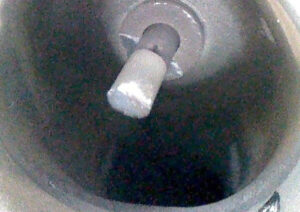Michigan-based ViewTech Borescopes is a leader in remote visual inspection. Its borescopes have a manipulatable probe and video technology that allows facility managers to create an archive of photos and videos to inform decisions about troubleshooting and preventive maintenance. In this interview, ViewTech’s director of sales and marketing, Duncan White, tells us about the company’s technology and its demo-before-you-buy sales philosophy.
Hydro Leader: Please tell us about your background and how you came to be in your current position.
Duncan White: I am the director of sales and marketing at ViewTech Borescopes. I have been here for about 10 years. My background is in online marketing. Before coming here, I worked as the director of client services, a sales role, at an internet marketing company.
Hydro Leader: Please tell us about ViewTech Borescopes.
Duncan White: We’re a small company of about 10 people based in Traverse City, Michigan. We are the exclusive distributor in the United States and Canada of ViewTech Borescopes for commercial and industrial applications. A borescope is a small inspection camera that can go inside places you can’t reach with your eyes. The technology is related to that used in medical endoscopes. The difference is that the borescope needs to be durable enough to work in industrial settings. With many types of inspection cameras, you can put the camera in, but you can’t move it around. We distribute a class of borescopes called articulating video borescopes, which means that their ends can be moved around to get a better view of the area that you’re inspecting.
Hydro Leader: How do potential customers learn about your products?
Duncan White: We market our products on the internet and sell primarily over the phone. We also do up to 25 trade shows a year. We let our customers demo the borescopes before they buy. Our expert sales consultants start by having a detailed conversation with the customer about their application. We can then ship the product and let the customer use it on site with the company’s own equipment. During that process, we talk to the customer and provide guidance about how to use the borescope. We find that in almost every case, once customers get the borescope into their hands, they realize that it’s not too difficult to use. Our business model is not set up for us to be there in person, though. We don’t offer the service of doing a borescope inspection; we only provide the equipment. We are able to keep a good inventory, so when a product is ordered, we can usually ship it out right away. If you order a borescope from some other companies, you have to wait for it to be made.
Hydro Leader: What are some of the municipal and hydro uses of these devices?
Duncan White: Borescopes are often used to inspect piping, and sometimes that piping is full of water. On the hydro side, the borescope can inspect a turbine engine, for example. Our handheld units have a maximum probe length of about 26 feet. Whereas sewer cameras can reach hundreds of yards, potentially even miles, our borescopes have a shorter reach, but they can take pictures. We’re trying to meet the need for a camera that can move around and take pictures and videos. Those images can be archived and used to inform decisions

about things like preventive maintenance, flawed attachments, and troubleshooting. Our borescopes can focus amazingly clearly at just a centimeter or even a few millimeters from a target. They range in diameter from 2.2 to 6 millimeters.
Hydro Leader: What would be the advantage of having a larger borescope?
Duncan White: That is a common question. The larger borescope is more durable and costs less. A larger-diameter borescope can fit more advanced cameras, so it can produce higher-quality images. When you’re inside a tiny space that requires a borescope that is 3 millimeters in diameter or smaller, you don’t need to be far away to take a picture. At the other extreme, some of our 6‑millimeter borescopes, which are called far-focused borescopes, are tremendously bright, and within certain limits, they can light up a cavity and let you take pictures up to a foot from your target.
Hydro Leader: Can the borescope propel itself, or does the user have to move it?
Duncan White: The user has to push the scope where it needs to go. The last 2 inches or so of the borescope contain the camera and the lighting. That section is controlled by a thumb-operated joystick. The smallest-diameter scope has what we call two-way articulation: You can move it 180 degrees to the left and 180 to the right, but you can’t swing it all the way around. Every other borescope we offer has what we call 360‑degree articulation. We have borescopes with 360‑degree articulation and a forward-facing camera. We also have a special series called dual cameras, which have a camera mounted 90 degrees on the side. With the dual camera borescope, it’s easy to quickly switch to the side view, and you can take pictures and videos with both the forward and side cameras. That gives you a more complete inspection.
Hydro Leader: What is the typical lifespan of one of these devices?
Duncan White: The typical lifespan is 10 years. Some devices last even longer. The borescope might need a couple of repairs in that lifespan, depending on the industry. Some applications are much harsher on borescopes than others— for instance, some inspections require the borescope to move past sharp metal edges that can damage it. Passageways inside a casted chunk of metal likely have sharp metal corners. You’ve got to make sure the passageways are clear and that the company that made them conducts routine repair and maintenance. Although our product is durable, it will eventually wear out. A new insertion tube can be put on, and that will essentially restore the borescope to a like-new state. We perform the repairs and provide customers with a loaner borescope to use until the repairs are complete.
Water treatment plant customers are not going to be exposing the borescope to anything too rugged. In general, they’re working in a more forgiving environment with more ample spaces, which allows them to use the larger 6‑millimeter borescope, and water, which won’t wear the borescope out.
Hydro Leader: Does the software require routine or periodic updates?
Duncan White: No software updates are required. All the processing is done by the little computer in the base unit of the borescope. You save your pictures and videos to an SD card. Later, you can connect the borescope to your computer via USB cable or just pop the SD card out.
Hydro Leader: What is the company’s vision for the future?
Duncan White: The industry is headed toward higher image quality, which means you’ll be able to take more detailed pictures. It’s a little bit like the Hubble telescope and the Webb telescope. You could do a tremendous amount of science with the Hubble images, but you could do even more science with the Webb. With the next wave of borescopes, you’ll have higher-quality images, and you’ll be able to edit the photos and images right in the device itself. You’ll have a Wi-Fi connection; the ability to annotate; and shareability, so that you can complete your borescope inspection and report the results right from the device.
Duncan White is the director of sales and marketing at ViewTech Borescopes. He can be contacted at dwhite@viewtech.com.


